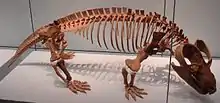Probainognathia
The probainognathians are members of one of the two major clades of the infraorder Eucynodontia, the other being Cynognathia. The earliest forms were carnivorous and insectivorous, though some groups eventually also evolved herbivorous diets. The earliest and most basal probainognathian is Lumkuia, from South Africa. Three groups survived the extinction at the end of Triassic: Tritheledontidae and Tritylodontidae, which both survived until the Jurassic—the latter even into the Cretaceous (Montirictus and Xenocretosuchus)—and Mammaliaformes, which gave rise to the mammals.[2]
| Probainognathia | |
|---|---|
 | |
| Fossil of the probainognathian Chiniquodon theotonicus in the Staatliches Museum für Naturkunde Stuttgart | |
| Scientific classification | |
| Kingdom: | Animalia |
| Phylum: | Chordata |
| Clade: | Therapsida |
| Clade: | Cynodontia |
| Clade: | Eucynodontia |
| Clade: | Probainognathia Hopson, 1990 |
| Subgroups | |
Phylogeny

Partial skeleton of an unidentified probainognathian from Madagascar in the Field Museum of Natural History, Chicago
Below is a cladogram from Ruta, Botha-Brink, Mitchell and Benton (2013) showing one hypothesis of cynodont relationships:[3]
| Eucynodontia |
| ||||||||||||||||||||||||||||||||||||||||||||||||||||||||||||||||||||||||||||||||||||||||||||||||||||||||||||||||||||||||||||||
References
- Martinelli, A.; Soares, M. B.; Oliveira, T.; Rodrigues, P.; Schultz, C. (2017). "The Triassic eucynodont Candelariodon barberenai revisited and the early diversity of stem prozostrodontians". Acta Palaeontologica Polonica. 62. doi:10.4202/app.00344.2017.
- The slow and fast steps to becoming a mammal
- Ruta, M.; Botha-Brink, J.; Mitchell, S. A.; Benton, M. J. (2013). "The radiation of cynodonts and the ground plan of mammalian morphological diversity". Proceedings of the Royal Society B: Biological Sciences. 280 (1769): 20131865. doi:10.1098/rspb.2013.1865. PMC 3768321. PMID 23986112.
This article is issued from Wikipedia. The text is licensed under Creative Commons - Attribution - Sharealike. Additional terms may apply for the media files.







